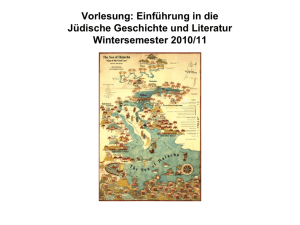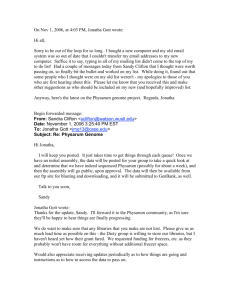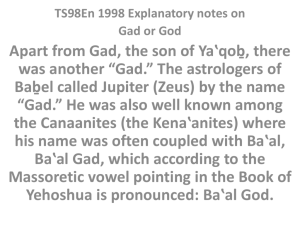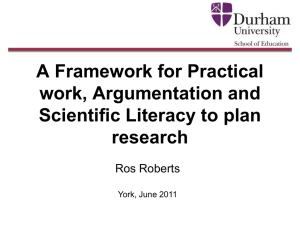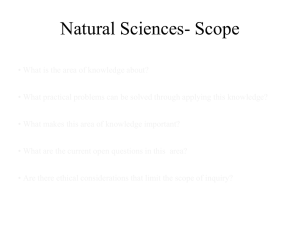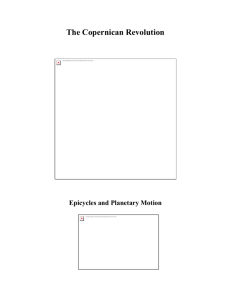Ppt - University of New Mexico
advertisement
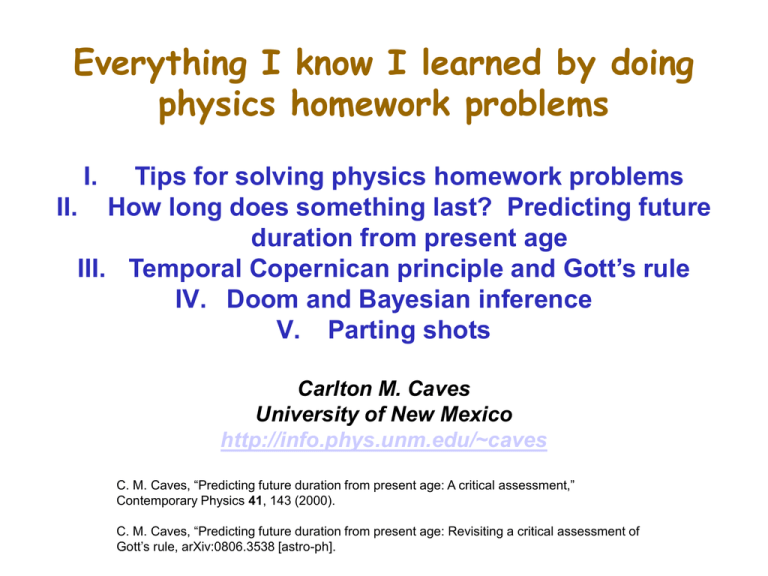
Everything I know I learned by doing physics homework problems I. Tips for solving physics homework problems II. How long does something last? Predicting future duration from present age III. Temporal Copernican principle and Gott’s rule IV. Doom and Bayesian inference V. Parting shots Carlton M. Caves University of New Mexico http://info.phys.unm.edu/~caves C. M. Caves, “Predicting future duration from present age: A critical assessment,” Contemporary Physics 41, 143 (2000). C. M. Caves, “Predicting future duration from present age: Revisiting a critical assessment of Gott’s rule, arXiv:0806.3538 [astro-ph]. I. Tips for solving physics homework problems Oljeto Wash Southern Utah Tips for solving physics homework problems http://info.phys.unm.edu/~caves/courses/probtech.pdf Getting started Try to develop a picture—something you can visualize—that captures the essence of the problem. Use symmetries to simplify your work. Identify the important scales—i.e., the important quantities with dimensions—before you start. Reason backward from the answer you are asked to supply to the concepts and information you need. Guess the answer, using any technique at your disposal, before you begin. If you don't need to know the answer exactly (you never really do), think about whether an easier approximate technique can be used. Before using advanced techniques, think whether the problem—or at least part of the problem—can be solved using elementary methods. Pause before you start work on a problem to try to think of a clever way to do it. Tips for solving physics homework problems http://info.phys.unm.edu/~caves/courses/probtech.pdf Doing the problem Don't put in numerical values till the end. Always use vector signs on vectors. Checking your answer Test your solution in any limiting case where you know the right answer from other considerations. Do the problem in two or more independent ways. Check that your answer has the proper units. Think about your answer critically, to see if it makes sense in light of other things you know. Real-life problems are often hard because they are poorly formulated and nobody knows the answer. It is even more important to know how to formulate the problem and to check your answer critically. Thinking critically about what you do is the foundation of scientific integrity. II. How long does something last? Predicting future duration from present age Cape Hauy Tasman Peninsula Predicting future duration from present age You observe a phenomenon some time after it begins. How long do you predict it will last? Phenomenon: Decaying atom Egg timer set for 10 minutes Person Homo sapiens Predicting future duration from present age Try to develop a picture—something you can visualize—that captures the essence of the problem. Predicting future duration from present age Check that your answer has the proper units. Predicting future duration from present age Identify the important scales—i.e., the important quantities with dimensions—before you start. Predicting future duration from present age Guess the answer, using any technique at your disposal, before you begin. Predicting future duration from present age Test your solution in any limiting case where you know the right answer from other considerations. Think about your answer critically, to see if it makes sense in light of other things you know. III. Temporal Copernican principle and Gott’s rule Cable Beach Western Australia Gott’s temporal Copernican principle Copernican principle: We are not at a special place. Temporal Copernican principle: We are not at a special time. J. R. Gott III, “Implications of the Copernican principle for our future prospects,” Nature 363, 315 (1993). Temporal Copernican principle and Gott’s rule Standing at the (Berlin) Wall in 1969, I made the following argument, using the Copernican principle. I said, Well, there's nothing special about the timing of my visit. I'm just travelling—you know, Europe on five dollars a day—and I'm observing the Wall because it happens to be here. My visit is random in time. So if I divide the Wall's total history, from the beginning to the end, into four quarters, and I'm located randomly somewhere in there, there's a fifty-per-cent chance that I'm in the middle two quarters—that means, not in the first quarter and not in the fourth quarter. Let's suppose that I'm at the beginning of that middle fifty per cent. In that case, one quarter of the Wall's ultimate history has passed and there are three quarters left in the future. In that case, the future's three times as long as the past. On the other hand, if I'm at the other end, then three quarters have happened already, and there's one quarter left in the future. In that case, the future is one-third as long as the past. … (The Wall was) eight years (old in 1969). So I said to a friend, “There's a fifty-percent chance that the Wall's future duration will be between (two and) two-thirds of a year and twenty-four years.” Twenty years later, in 1989, the Wall came down, within those two limits that I had predicted. I thought, Well, you know, maybe I should write this up. T. Ferris, “How to predict everything: Has the physicist J. Richard Gott found a way?” The New Yorker 75(18) 35 (1999 July 12). Temporal Copernican principle and Gott’s rule “Homo sapiens has been around for two hundred thousand years,” Gott said. … “That's how long our past is. Two and half per cent is equal to one-fortieth, so the future is probably at least one-thirty-ninth as long as the past but not more than thirty-nine times the past. If we divide two hundred thousand years by thirty-nine, we get about fifty-one hundred years. If we multiply it by thirty-nine, we get 7.8 million years. So if our location in human history is not special, there's a ninety-five-per-cent chance we're in the middle ninety-five per cent of it. Therefore the human future is probably going to last longer than fifty-one hundred years but less than 7.8 million years. “Now, those numbers are interesting, because they give us a total longevity that's comparable to that of other species.” T. Ferris, “How to predict everything: Has the physicist J. Richard Gott found a way?” The New Yorker 75(18) 35 (1999 July 12). Gott’s rule Gott’s rule Picture? Clever approach? Units? Cases: Decaying atom? Egg timer? Person? Scales? Two ways? Think critically? Himself Stonehenge Christianity The Seven Wonders of the World The former Soviet Union Canada World leaders Nature Wall Street Journal The New York Times Thatcher-Major government in the UK The New York Stock Exchange The Pantheon The Third Reich The United States This is a professor who didn’t do his homework. Should we try to figure out where he went wrong? Oxford University The Great Wall of China The Internet The Berlin Wall Microsoft The Astronomical Society of the Pacific The 44 Broadway and off-Broadway plays open and running on 1993 May 27 General Motors The human spaceflight program Homo sapiens Explicating Gott’s rule Gott’s line Explicating Gott’s rule Unrestricted Copernican ensemble Try to develop a picture—something you can visualize—that captures the essence of the problem. Explicating Gott’s rule Unrestricted Copernican ensemble Use symmetries to simplify your work. Explicating Gott’s rule Truncated Copernican ensemble Explicating Gott’s rule Explicating Gott’s rule: A baseball game Truncated Copernican ensemble The diagonal subensemble for total duration T is a realization of Gott’s line, but it does not warrant making predictions of future duration based on present age. The total population of a diagonal subensemble is proportional to Tw(T), not w(T). IV. Doom and Bayesian inference Echidna Gorge Bungle Bungle Range Western Australia The doomsday argument J. Leslie, The End of the World: The Science and Ethics of Human Extinction (Routledge, London, 1996).. Clever approach? Units? Cases: Decaying atom? Egg timer? Person? Scales? Two ways? Think critically? Updates? DOOM The doomsday argument DOOM V. Parting shots Pecos Wilderness Sangre de Cristo Range Northern New Mexico More baseball White Sox Gott predicted in 1996 that the Sox, having not won a World Series title since 1917, would, with 95% confidence, win a Series sometime between 1999 and 5077. Gott would have predicted a World Series title in 2005 or before with probability 0.10, considerably less than the probability, 1 - (29/30)9 = 0.26, that comes from assuming that the Sox had the same chance each year as the 30 other major-league ball clubs. The Sox won the 2005 World Series title. More baseball Cubs The Cubs have now had a World Series drought of a century. Gott would predict that with probability ½ they will not a win a Series for the next century. Giving the Cubs the same chance each year as all the other clubs gives a probability (29/30)100 = 0.034 of having a further 100-year drought. Gott’s prediction corresponds to giving the Cubs a probability 1 - 1/20.01 = 0.007 of winning each year, about a factor of 5 less than 1/30.
